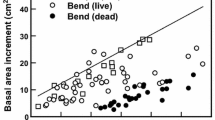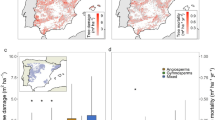Abstract
Tree mortality from drought is anticipated to increase as climate change promotes more frequent or severe water limitation. Ecosystem impacts of woody mortality depend on both the number and sizes of trees that die, but a limited capacity to predict mortality risk for individual trees hinders the capacity to forecast drought effects on tree population demography and ecosystem processes. We remotely measured leaf area of living Ashe juniper trees at three savanna sites in central Texas, USA to characterize the frequency-size distribution (FSD) of juniper populations and evaluate mortality risk from drought as a function of tree size. Mortality risk of individuals was assessed from the deviation in leaf area per tree from that of a similarly sized individual with near maximal leaf area using correlations among leaf area, growth rate, and mortality measured during a prior drought. We found that the FSD of juniper trees is bell-shaped at each site. Mortality risk from drought exceeded 25% of emergent (> 4 m height) trees in savanna juniper populations, but was highest for largest trees. Mortality risk was greatest at a grazed savanna, exceeding 50% of trees with projected canopy area > 20 m2. Results imply that severe drought could kill a large fraction (18–85%) of intermediate- to large-sized Ashe juniper trees in central Texas savannas. Our analysis demonstrates a novel use of remote measurements of canopy foliation to link mortality risk from drought to the demography of Ashe juniper populations through properties of individual trees.





Similar content being viewed by others
References
Adams HD, Luce CH, Breshears DD, Allen CD, Weiler M, Hale VC, Smith AMS, Huxman TE (2012) Ecohydrological consequences of drought- and infestation-triggered tree die-off: insights and hypotheses. Ecohydrology 5:145–159
Allen CD, Macalady AK, Chenchouni H, Bachelet D, McDowell N, Vennetier M, Kitzberger T, Rigling A, Breshears DD, Hogg EH, Gonzalez P, Fensham R, Zhang Z, Castro J, Demidova N, Lim J-H, Allard G, Running SW, Semerci A, Cobb N (2010) A global overview of drought and heat-induced tree mortality reveals emerging climate change risks for forests. For Ecol Manage 259:660–684. https://doi.org/10.1016/j.foreco.2009.09.001
Allred BW, Fuhlendorf SD, Smeins FE, Taylor CA (2012) Herbivore species and grazing intensity regulated community composition and an encroaching woody plant in semi-arid rangeland. Basic Appl Ecol 13:149–158
Anderegg WRL, Martinez-Vilalta J, Cailleret M, Camarero JJ, Ewers BE, Galbraith D, Gessler A, Grote R, Huang C, Levick SR, Powell TL, Rowland L, Sánchez-Salguero R, Trotsiuk V (2016) When a tree dies in the forest: scaling climate-driven tree mortality to ecosystem water and carbon fluxes. Ecosystems 19:1133–1147
Belsky AJ, Amundson RG, Duxbury JM, Riha SJ, Ali AR, Mwonga SM (1989) The effects of trees on their physical, chemical, and biological environments in a semi-arid savanna in Kenya. J Appl Ecol 26:1005–1024
Bennett AC, McDowell NG, Allen CD, Anderson-Teixeira KJ (2015) Larger trees suffer most during drought in forests worldwide. Nat Plants. https://doi.org/10.1038/nplants.2015.139
Cade BS, Noon BR (2003) A gentle introduction to quantile regression for ecologists. Front Ecol Environ 1:412–420
Carnicer J, Coll M, Ninyerola M, Pons X, Sánchez G, Peñuelas J (2011) Widespread crown condition decline, food web disruption, and amplified tree mortality with increased climate change-type drought. Proc Natl Acad Sci USA 108:1474–1478
Colgan MS, Baldeck CA, Féret J-B, Asner GP (2012) Mapping savanna tree species at ecosystem scales using support vector machine classification and BRDF correction on airborne hyperspectral and LiDAR data. Remote Sens-Basel 4:3462–3480
Coomes DA, Duncan RP, Allen RB, Truscott J (2003) Disturbances prevent stem size-density distributions in natural forests from following scaling relationships. Ecol Lett 6:980–989
Feilhauer H, Asner GP, Martin RE, Schmidtlein S (2010) Brightness-normalized partial least squares regression for hyperspectral data. J Quant Spectrosc Radiat Transfer 111:1947–1957
Fensham RJ, Freeman ME, Laffineur B, Macdermott H, Prior LD, Werner PA (2017) Variable rainfall has a greater effect than fire on the demography of the dominant tree in a semi-arid Eucalyptus savanna. Austral Ecol 42:772–782
Floyd ML, Clifford M, Cobb NS, Hanna D, Delph R, Ford P, Turner D (2009) Relationship of stand characteristics to drought-induced mortality in three Southwestern piñon-juniper woodlands. Ecol Appl 19:1223–1230
Guardiola-Claramonte M, Troch PA, Breshears DD, Huxman TE, Switanek MB, Durcik M, Cobb NS (2011) Decreased streamflow in semi-arid basins following drought-induced tree die-off: a counter-intuitive and indirect climate impact on hydrology. J Hydrol 406:225–233. https://doi.org/10.1016/j.jhydrol.2011.06.017
Hoerling M, Kumar A, Dole R, Nielsen-Gammon JW, Eischeid J, Perlwitz J, Quan X-W, Zhang T, Pegion P, Chen M (2013) Anatomy of an extreme event. J Climate 26:2811–2832. https://doi.org/10.1175/JCLI-D-12-00270.1
Huang C, Asner GP, Barger NN, Neff JC, Floyd ML (2010) Regional aboveground live carbon losses due to drought-induced tree dieback in piñon-juniper ecosystems. Remote Sens Environ 114:1471–1479
IPCC (2013) Climate change 2013: The physical science basis. Working Group I contribution to the Fifth assessment report of the Intergovernmental Panel on climate change. Cambridge University Press, Cambridge
Johnson DM, Domec J-C, Berry ZC, Schwantes AM, McCulloh KA, Woodruff DR, Polley HW, Wortemann R, Swenson JJ, Mackay DS, McDowell NG, Jackson RB (2018) Co-occurring woody species have diverse hydraulic strategies and mortality rates during an extreme drought. Plant Cell Environ 41:576–588
Michaelian M, Hogg EH, Hall RJ, Arsenault E (2011) Massive mortality of aspen following severe drought along the southern edge of the Canadian boreal forest. Glob Change Biol 17:2084–2094. https://doi.org/10.1111/j.1365-2486.2010.02357.x
Moore GW, Edgar CB, Vogel JG, Washington-Allen RA, March RG, Zehnder R (2016) Tree mortality from an exceptional drought spanning mesic to semiarid ecoregions. Ecol Appl 26:602–611
Mueller RC, Scudder CM, Porter ME, Trotter RT III, Gehring CA, Whitham TG (2005) Differential tree mortality in response to severe drought: evidence for long-term vegetation shifts. J Ecol 93:1085–1093
Noel JM, Fowler NL (2007) Effects of fire and neighboring trees on Ashe juniper. Rangel Ecol Manage 60:596–603
Ogle K, Whitham TG, Cobb HS (2000) Tree-ring variation in pinyon predicts likelihood of death following severe drought. Ecology 81:3237–3243
Pedersen BS (1998) The role of stress in the mortality of midwestern oaks as indicated by growth prior to death. Ecology 79:79–93
Peng CH, Ma ZH, Lei XD, Zhu QA, Chen H, Wang WF, Liu SR, Li WZ, Fang XQ, Zhou XL (2011) A drought induced pervasive increase in tree mortality across Canada’s boreal forests. Nat Clim Change 1:467–471
Pfeifer EM, Hicke JA, Meddens AJH (2011) Observations and modeling of aboveground tree carbon stocks and fluxes following a bark beetle outbreak in the western United States. Glob Change Biol 17:339–350
Polley HW, Johnson DM, Jackson RB (2016) Canopy foliation and area as predictors of mortality risk from episodic drought for individual trees of Ashe juniper. Plant Ecol 217:1105–1114
Riskind DH, Diamond DD (1988) An introduction to environments and vegetation. In: Amos BB, Gehlbach FR (eds) Edwards Plateau vegetation—plant ecological studies in central Texas. Baylor University Press, Waco, pp 1–15
Schwantes AM, Swenson JJ, Jackson RB (2016) Quantifying drought-induced tree mortality in the open canopy woods of central Texas. Remote Sens Environ 181:54–64
Schwantes AM, Swenson JJ, González-Roglich M, Johnson DM, Domec J-C, Jackson RB (2017) Measuring canopy loss and climatic thresholds from an extreme drought along a 5-fold precipitation gradient across Texas. Glob Change Biol 23:5120–5135. https://doi.org/10.1111/gcb.13775
Schwinning S (2008) The water relations of two evergreen tree species in a karst savanna. Oecologia 158:373–383
Smeins FE, Merrill LB (1988) Long-term change in a semi-arid grassland. In: Amos BB, Gehlbach FR (eds) Edwards plateau vegetation—plant ecological studies in central Texas. Baylor University Press, Waco, pp 101–114
Stephenson NL, Das AJ, Condit R, Russo SE, Baker PJ, Beckman NG, Coomes DA, Lines ER, Morris WK, Rüger N et al (2014) Rate of tree carbon accumulation increases continuously with tree size. Nature 507:90–93
Suarez ML, Ghermandi L, Kitzberger T (2005) Factors predisposing episodic drought-induced tree mortality in Nothofagus: site, climatic sensitivity, and growth trends. J Ecol 92:954–966
Taucer PI, Munster CL, Wilcox BP, Owens MK, Mohanty BP (2008) Large-scale rainfall simulation experiments on juniper rangelands. T ASABE 51:1951–1961
Taylor CA Jr, Twidwell D, Garza NE, Rosser C, Hoffman JK, Brooks TD (2012) Long-term effects of fire, livestock herbivory removal, and weather variability in Texas semiarid savanna. Rangel Ecol Manage 65:21–30
Trenberth KE, Dai A, van der Schrier G, Jones PD, Barichivich J, Briffa KR, Sheffield J (2014) Global warming and changes in drought. Nature Clim Change 4:17–22
Wold S, Ruhe A, Wold H, Dunn WJ III (1984) The collinearity problem in linear regression. The partial least squares (PLS) approach to generalized inverses. SIAM J Sci Stat Comput 5:735–743
Acknowledgements
Assistance from Chris Kolodziejczyk and Katherine Jones was critical. We are indebted to Texas Parks and Wildlife staff at Colorado Bend State Park and Ms. Lois Reiter for their gracious cooperation. This project was funded under a Grant from USDA-AFRI (#2012-00857). Mention of trade names or commercial products does not imply endorsement by the US Department of Agriculture. USDA is an equal opportunity provider and employer.
Author information
Authors and Affiliations
Corresponding author
Additional information
Communicated by Carissa Lyn Wonkka.
Rights and permissions
About this article
Cite this article
Polley, H.W., Johnson, D.M. & Jackson, R.B. Projected drought effects on the demography of Ashe juniper populations inferred from remote measurements of tree canopies. Plant Ecol 219, 1259–1267 (2018). https://doi.org/10.1007/s11258-018-0876-5
Received:
Accepted:
Published:
Issue Date:
DOI: https://doi.org/10.1007/s11258-018-0876-5




